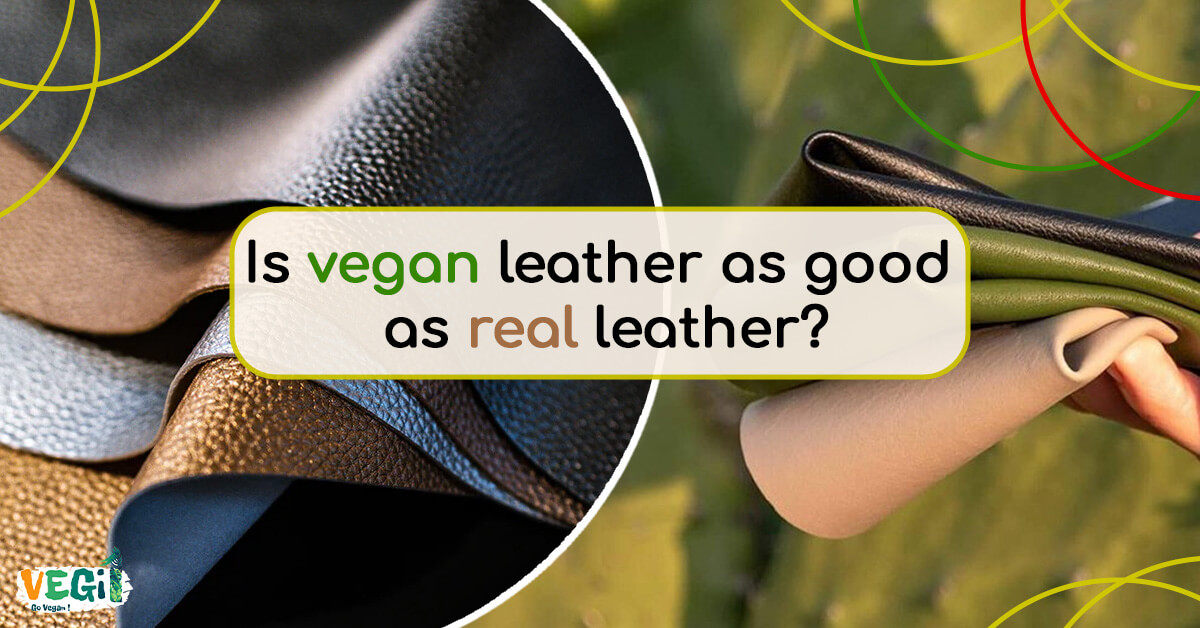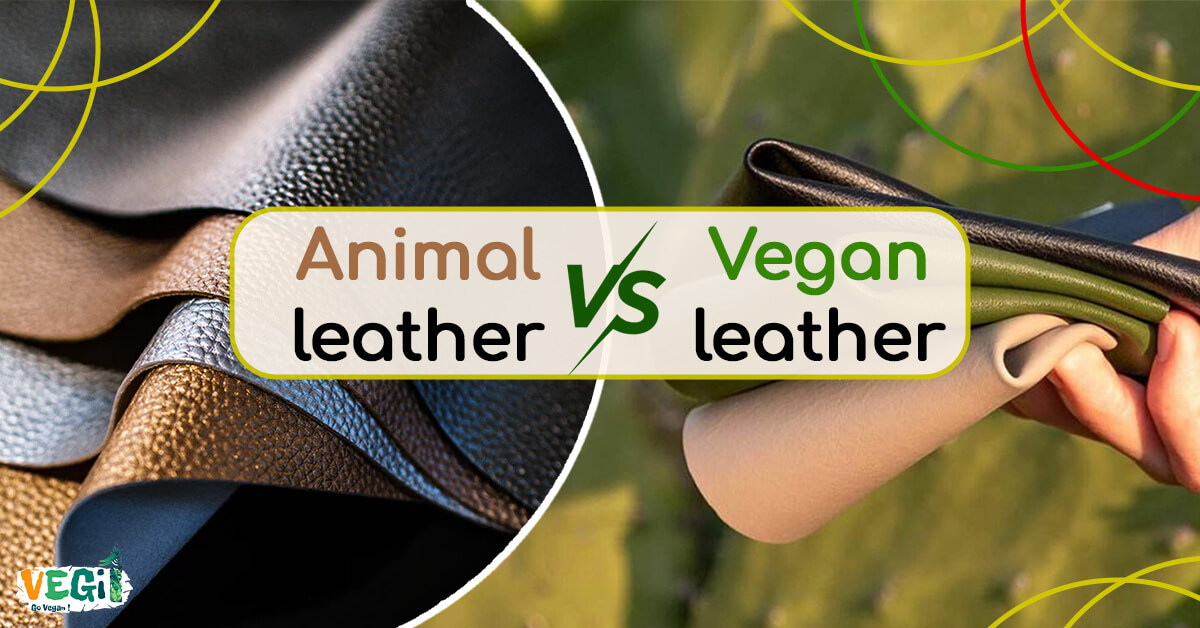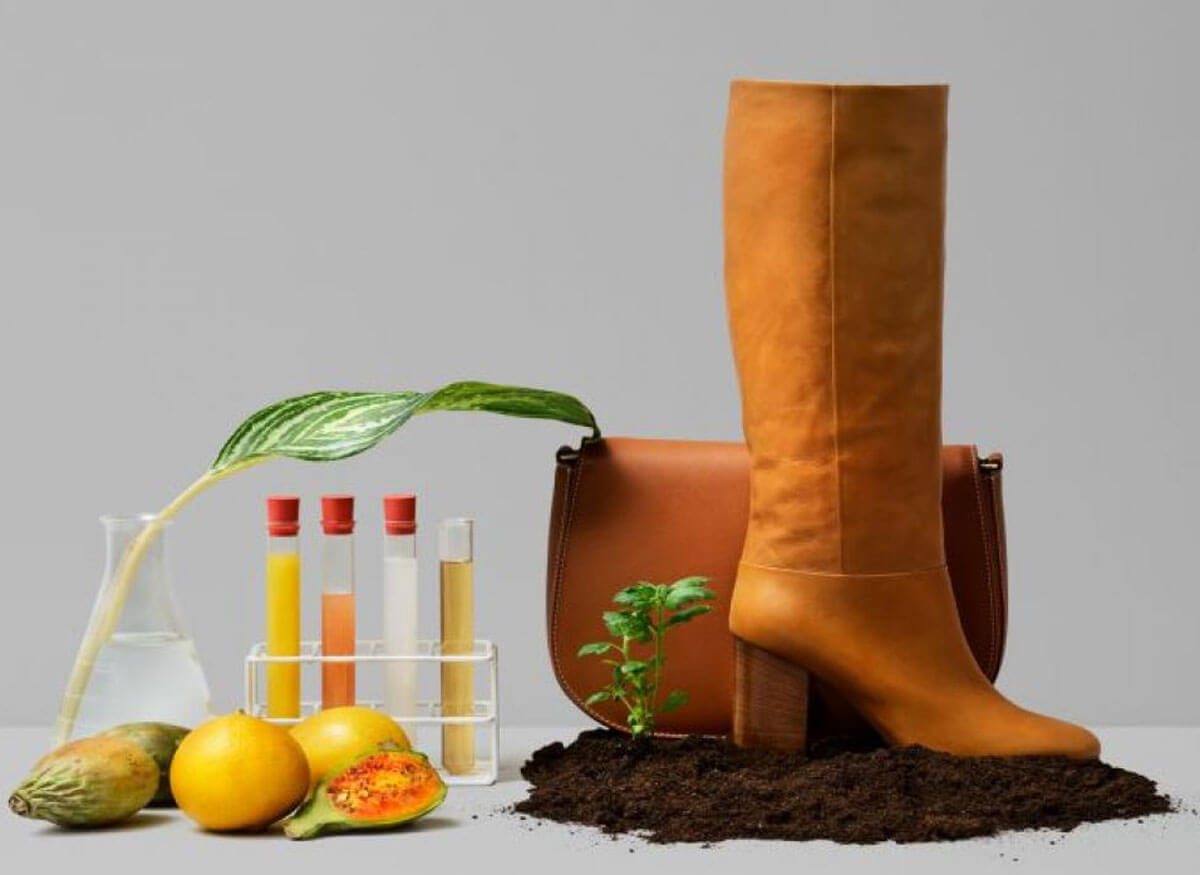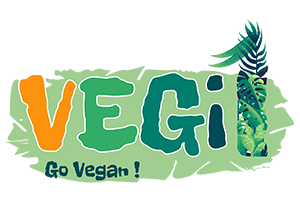Is vegan leather as good as real leather?

Is vegan leather as good as real leather?
In recent years, the debate between real leather and vegan leather has gained significant attention. People are becoming more conscious of animal leather’s environmental impact and ethical concerns. Vegan leather, also known as faux leather, offers an alternative that does not use animal skin.
Have you ever wondered if vegan leather can match up to the real deal? It’s a question that’s been boggling my mind lately as I navigate the world of ethical fashion.
When choosing between real leather and its plant-based counterpart, there’s more to consider than meets the eye.
On the one hand, we have the timeless allure and durability of real leather, but on the other, there’s the eco-friendly and cruelty-free appeal of vegan leather.
But is vegan leather as good as real leather? Let’s delve into the details and compare the two and exploring about materials, delving into their sustainability, durability, and ethical impact to help you make an informed decision and Find the best answer: “Is vegan leather as good as real leather?”
In this article you will read:
Dark Side of Leather Production: Why Choosing Vegan Leather Makes a Difference
As you know, leather is a common material used in various products like shoes, bags, and accessories, but I’d like to shed some light on the horrible side of leather production.
Real leather is derived from animal skins and hides, such as cattle, Sheep, goats, cows, snakes, lizards, crocodiles, dogs and cats, otters, foxes, squirrels, and alligators. Animal skin has been a popular material in the fashion industry for centuries due to its durability and luxurious feel. Let’s explore the process of real leather.
When I think about the process of obtaining animal leather, it’s heart-wrenching to imagine the pain and fear these innocent creatures go through. Many animals, including cows, snakes, lizards, horses, and even pets like cats and dogs, suffer immensely in the name of fashion and luxury.
Watch this video : The Dirty Truth Behind Luxury Leather
They are often raised in crowded and unsanitary conditions, and their lives are often shortened to meet the demand for leather goods.
Their skin is cut alive so that the leather industry can provide people with luxury clothes, shoes, and bags for luxury parties, and it’s a horrifying and inhumane practice that we vegans cannot ignore.
Disadvantages of animal leather
Now, the impact on animal life. It’s no secret that animal leather is directly tied to the loss of animal lives.
The saddest part is that many of these animals experience endure painful procedures like tail docking, dehorning, and tannery before they’re killed. It’s also important you know that not all leather is a by-product of the meat industry, and some animals are specifically raised for their skins and the leather industry.
Aside from the ethical aspect, there are practical reasons to opt for vegan leather.
First off, sensitization is a real concern with animal leather.
Animal leather is allergenic, and it can harbor germs and bacteria, which can pose health risks. On the other hand, vegan leather can be easier to clean and maintain while being equally stylish and durable.
Moreover, I think these products have high “negative energy.” Wearing or using something that comes from a tortured creature can have a very negative effect on us and our lives.
Next up, let’s talk energy. Producing animal leather demands substantial energy, from raising livestock to the various stages of leather production.
This energy-intensive process contributes to environmental burdens and carbon emissions, bursting our eco-conscious bubbles.
Whether from cattle, sheep, or other creatures, the leather industry’s demand plays a significant role in driving livestock farming, often leading to deforestation and habitat destruction, bursting the natural balance.
Vegan leather also tends to have lower carbon emissions compared to real leather. In some cases, vegan leather is made from recycled plastics or natural materials like pineapple leaves, apple peels, or cork, making it a more sustainable option.
As a vegan, I choose to opt out of this process and instead support cruelty-free alternatives.
There are plenty of fantastic materials out there that are both ethical and sustainable, like synthetic leathers made from plant-based or recycled materials.
By choosing vegan leather, we can make a significant difference in the lives of millions of animals. Vegan alternatives offer a cruelty-free option that doesn’t involve harming or exploiting animals. It’s a way to stand up against the inhumane practices of the leather industry.

How vegan leather is fabricated & what is its source?
Vegan leather is like a chameleon of the fashion world, adapting to various forms and textures. But how is it made? Well, it’s a creative blend of science and artistry.
The most common vegan leather types are crafted from synthetic polymers like polyurethane (PU) and polyvinyl chloride (PVC) or Microfiber.
These materials are processed and treated to create a leather-like material without using any animal products or harmful synthetic chemicals.
The process begins with coating PU or PVC on a base material like nylon, polyester, or cotton. Then, manufacturers work their magic to create the desired texture and color using additive treatments.
Vegan leather is made from recycled plastics or natural materials like pineapple leaves, apple peels, Cactus leaves, or cork, making it a more sustainable option.
It’s like a culinary adventure, where they blend the right ingredients to achieve that authentic leather look and feel.
But wait, there’s more! Remember how I mentioned the uprising trend of vegan leather made from natural materials?
Well, wait a moment! Bracelets made from pineapple leaves, wallets from apple peels, and even bags from cork and unique bags and shoes made from cactus leaves are all part of this sustainable revolution.
It’s incredible how nature’s gifts can be transformed into stylish accessories, reducing the environmental impact.
So, there’s an option for every ethical fashion enthusiast, whether it’s the classic PU and PVC blends or the earthy touch of pineapple and apple-derived vegan leathers.
The world of vegan leather fabrication is a fusion of science, creativity, and eco-consciousness.
So next time you slip into that chic faux leather jacket or flaunt that trendy cork bag, remember the story behind it – the innovative way we’re crafting cruelty-free and sustainable fashion.
Let’s embrace the versatility of vegan leather and positively impact the planet!
Characterization of vegan leather types
Each vegan leather variety has unique characteristics and charm, like a colorful bouquet.
So, get ready for a burst of information!
First up, we have the ever-reliable polyurethane (PU) vegan leather. PU vegan leather is a popular choice for its versatility and durability.
It’s water-resistant and can be made to look just like the real deal. I love rocking PU leather jackets and boots because they’re stylish, and with a smooth finish and a wide array of colors, they effortlessly adapt to various styles.
Next on the list is the intriguing polyvinyl chloride (PVC) vegan leather. PVC leather tends to be shinier and more rigid, creating a sleek and polished appearance.
You’ll find some awesome PVC bags and accessories out there on online sites that add a touch of cruelty-free chic to any outfit.
However, it’s essential to consider the environmental impact, as PVC production involves hazardous chemicals and is less biodegradable.
Some eco-conscious brands use recycled plastics, like old PET bottles, to create fabulous vegan leather. It’s a win-win! We get stylish items while helping reduce plastic waste. How cool is that?
Nature’s gifts come to life with vegan leathers made from pineapple leaves, apple peels, and cork.
The earthy touch of these materials adds a unique charm to accessories. Plus, they offer a sustainable alternative, making Mother Earth smile.
Moreover, Mycelium leather is made from the root system of mushrooms. It offers a natural and biodegradable alternative to leather Upholstery.
But wait, there’s more! Some vegan leathers even combine natural elements with synthetic materials to achieve the best of both worlds. These hybrids showcase innovation and creativity, providing even more options for conscious fashionistas.
Each variety has a distinct personality, offering choices for environmentally-conscious and style-savvy individuals.
So, my friends, there you have it – a captivating characterization of vegan leather types.
From classy boots to trendy sneakers and Totes, clutches, and backpacks, there’s a vegan option for every mood and occasion.
They add a touch of edginess to any outfit, and I love knowing that my style harmed no animals.
I’m all about decking out my living space with cruelty-free options. Vegan leather furniture gives my home a chic vibe. Plus, it’s so easy to clean – no worries about spills!
Remember, you can look fabulous with vegan leather while positively impacting the planet.
Advantages of choosing vegan leather on the environment
First and foremost, one of the most significant perks of choosing vegan leather is its positive impact on our furry friends.
By choosing plant-based materials like polyurethane (PU) and polyvinyl chloride (PVC), we’re saying a resounding “NO” to animal exploitation. No animals harmed – that’s a huge win!
Vegan leather also plays a starring role in reducing our carbon footprint.
Vegan leather production emits lower carbon emissions than its real leather counterpart, making it a more environmentally friendly choice.
And guess what? Vegan leather even helps in waste reduction.
Since it’s often made from recycled plastic or natural materials, we’re giving new life to existing resources, contributing to a circular economy.
The rise of vegan leather from materials like pineapple leaves, apple peels, and cork is a testament to human creativity in finding sustainable alternatives.
So, my friends, choosing vegan leather isn’t just about fashion; it’s about being kind to the planet.
By opting for ethical and eco-friendly materials, we’re taking steps towards a brighter, greener future for all living beings.

Comparison of vegan leather and animal leather: elasticity, durability, and quality
You should know that vegan leather has an elastic charm. Certain types of vegan leather, like those made from PU, can exhibit decent flexibility and adaptability.
Now, let’s talk about durability.
High-quality vegan leather can hold up well in the short term, especially when resisting moisture and mold formation.
Real leather is known for its durability and ability to last for decades when cared for properly. In contrast, vegan leather, especially those made with PVC, tends to be thinner and less durable.
The natural variations in the hides add a touch of uniqueness and sophistication to each piece.
Real leather develops a patina over time, giving it a unique and timeless appearance. Vegan leather, being synthetic, does not develop a patina and may have a more uniform appearance.
Vegetable leather offers a more sustainable and eco-friendly option compared to traditional vegan leather made from PVC or PU. It is biodegradable, renewable, and reduces the reliance on fossil fuels. Additionally, vegetable leather has a unique and natural aesthetic, with variations in texture and color that add to its appeal.
High-quality vegan leather can closely resemble real leather in terms of aesthetics.
With advancements in manufacturing, high-grade vegan leather can now closely mimic the look and feel of real leather, offering a burst of style without compromising our ethical choices.
So, my eco-friendly pals, there are plenty of alternatives to explore! Vegan leather, with its growing popularity, offers a stylish and conscious burst of choices, helping us embrace fashion with a lighter environmental footprint.

Vegan leather Brands
Now, let’s explore some vegan leather brands—a burst of creativity and conscious fashion choices that’ll leave you perplexed (in a good way)!
-
Nanushka
First on our list is Nanushka, a brand about sustainable fashion, bursting with unique styles crafted from polyurethane-based vegan leather.
Their commitment to eco-friendly practices and chic designs will surely perplex you with delight.
-
Matt & Nat
Next, we have Matt & Nat, a brand that offers versatility in vegan leather accessories. Their collections are trendy and environmentally responsible, with materials like recycled nylon and cork bursting with ingenuity.
-
Stella McCartney
Take advantage of Stella McCartney, an iconic name in the fashion world, bursting with high-end luxury made from animal-free materials.
Their commitment to ethical practices and top-notch designs will leave you bursting with admiration.
- Bourgeois Boheme
And let’s not forget about Bourgeois Boheme, a brand dedicated to cruelty-free fashion, bursting with innovative materials like Piñatex, derived from pineapple leaves.
Their unique creations will perplex you with their sustainable charm.
-
Will’s Vegan Shoes
Finally, for a variety, explore the collections of Will’s Vegan Shoes, a brand that offers a wide range of vegan leather footwear for every style and occasion.
With a focus on comfort and sustainability, they’ll leave you bursting with joy!
So, there you have it, my fashion-forward friends, some information on fantastic vegan leather brands.
9 Ways to distinguish natural leather from synthetic leather
Here, I have written several ways to distinguish natural leather (bloody) from artificial leather to help you choose and make a decision:
- First and foremost, check the label! Look for terms like “faux leather,” “synthetic leather,” or “vegan leather.” These labels indicate that the product is free from animal-derived materials.
- Next, feel the texture! Unlike real leather with natural imperfections, vegan leather usually boasts a uniform and consistent texture. Run your fingers over the surface, and you’ll notice the difference.
- Natural leather is the skin of a living being, and it has pores. If you pour a drop of water on it, it will gradually absorb it, while synthetic glue does not absorb water.
- Blood leather or natural leather does not have a smooth surface and does not reflect light. In contrast, light is reflected on artificial leather.
- The skin of living organisms has non-repetitive and non-uniform grooves, but artificial leather has repetitive lines and grooves.
- Synthetic leather shrinks in front of the flame. But, natural animal leather smells similar to burning human hair and emits white smoke when burning.
- The back of natural leather is fluffy, and the back of artificial leather has grids with sewn thread. Of course, maybe the lining of the dress prevents you from seeing the back of the leather. But you can tell from the edges and borders of the leather because natural leather has rough cuts, but synthetic leather has a smooth edge.
- Keep an eye out for the smell! Genuine leather has a distinctly earthy, animal-like scent. The same smell as the body of an animal whose head has been cut off, whereas vegan leather tends to be odorless or might have a faint chemical smell.
- Natural leather has a much higher price because the buyer is going to pay the blood price of the death of an animal, and the production cost is higher.
Finally, do some research! Look up the brand and its ethical practices. Many companies proudly promote vegan-friendly products, And you can find very beautiful products that are produced without shedding the blood of innocent animals.

Let’s wrap it up
Exploring the debate that vegan leather is as good as real leather has shed light on their distinct characteristics and environmental implications.
While real leather boasts durability and a unique aging process, vegan leather emerges as a more ethically conscious alternative.
As conscious consumers, we can shape the fashion industry’s future and impact on our planet.
What leather choice will we make? Will we prioritize sustainability, innovation, and compassion by embracing vegan leather?
Let’s take a step towards a more responsible and eco-friendly fashion world.
What’s your choice?
By opting for vegan or vegetable leather, you are supporting a more compassionate and sustainable fashion industry. Let’s embrace these alternatives and work towards a future where fashion and ethics go hand in hand.










